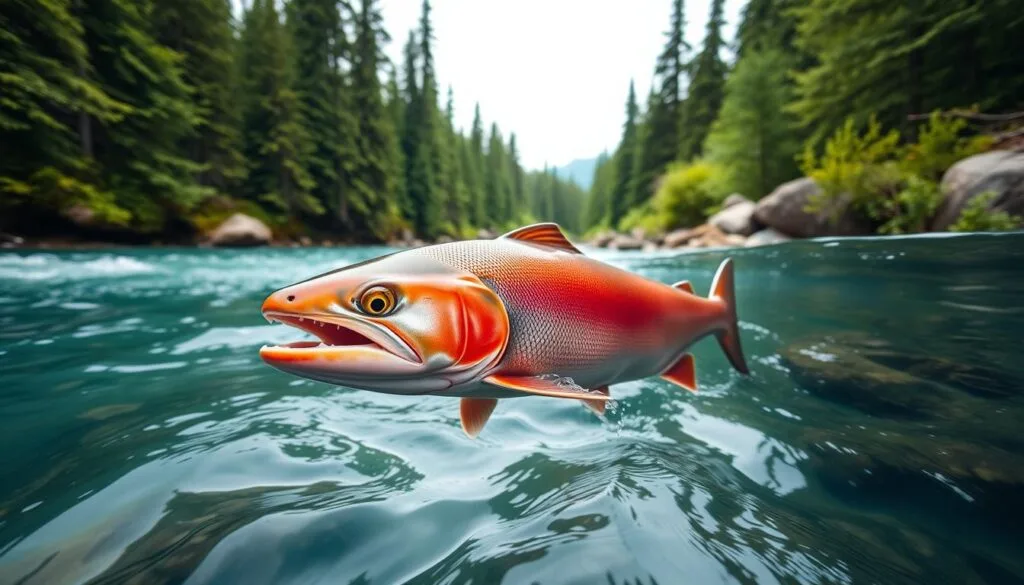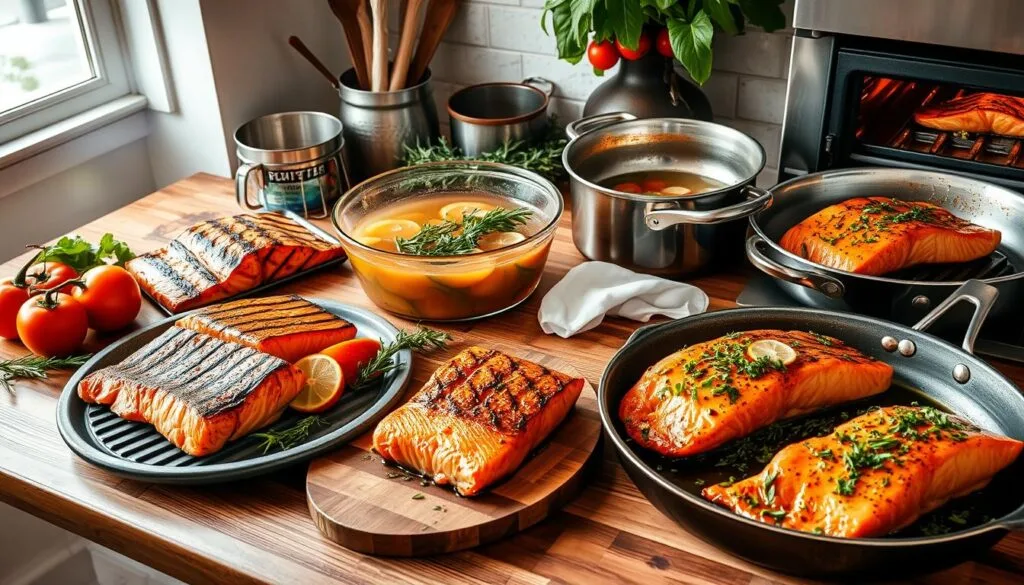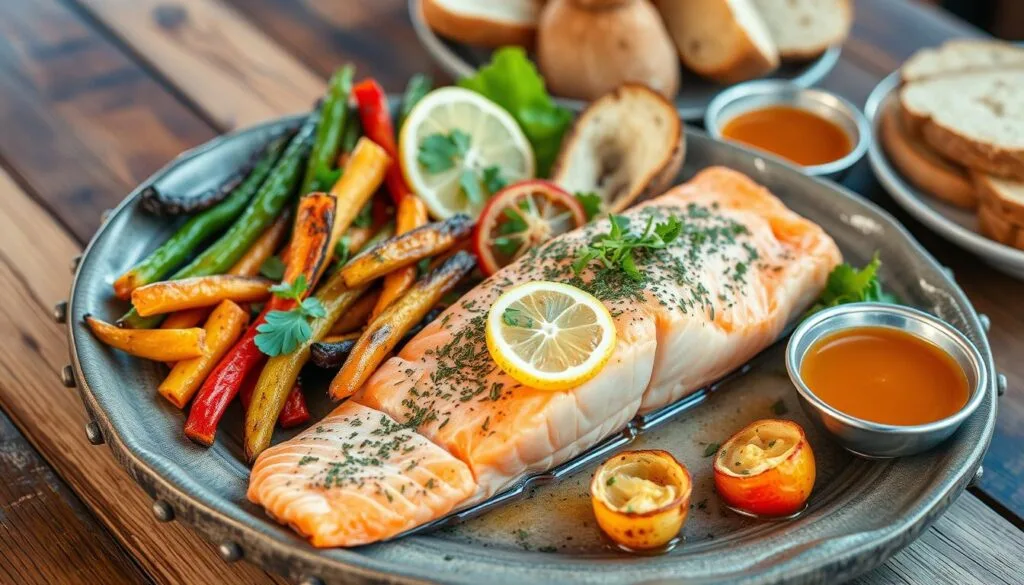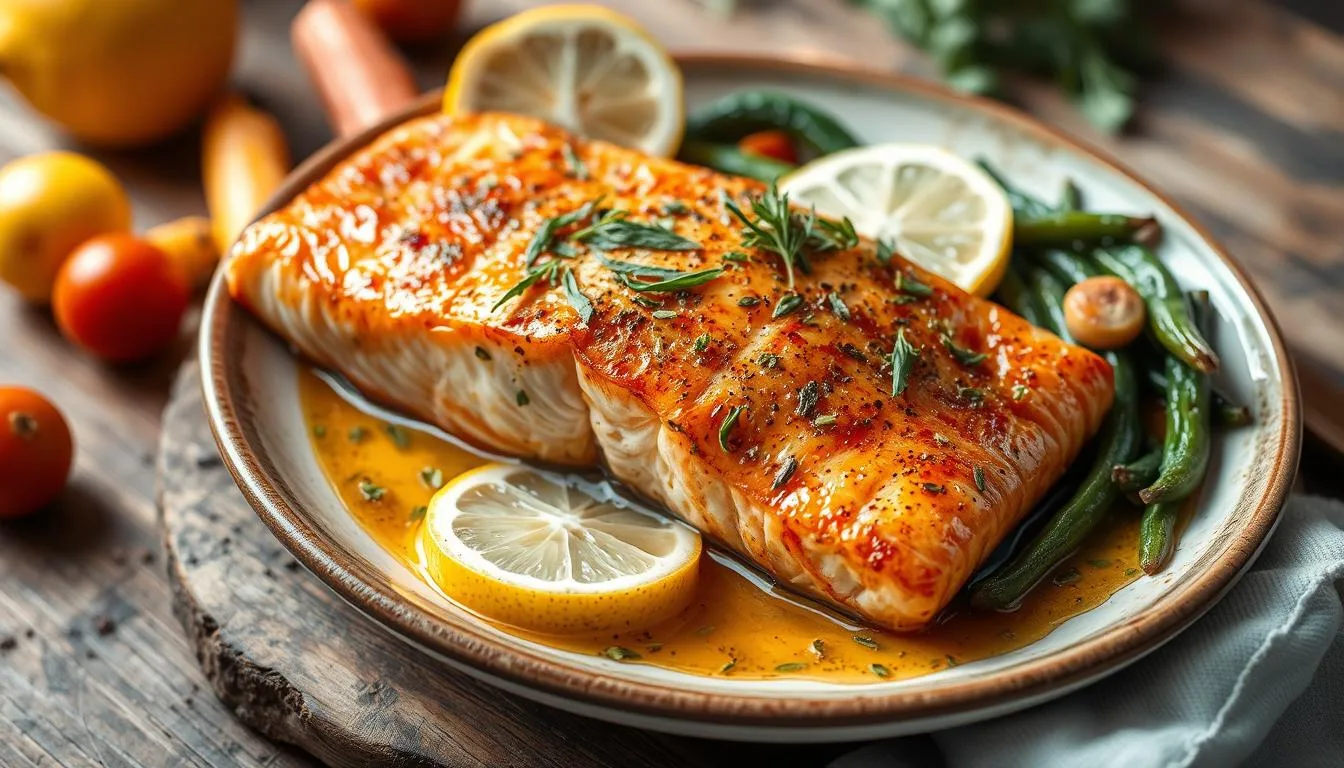Every time I unwrap a fresh wild-caught salmon, I’m transported to the pristine waters of Alaska. The rich, vibrant color and delicate texture speak of a culinary journey that begins in the cold, clean rivers where these magnificent fish thrive. Wild Salmon isn’t just a meal—it’s an experience that connects you to nature’s most remarkable seafood.
As a premium seafood, Ocean-Caught Salmon represents the pinnacle of taste and nutrition. Unlike its farmed counterparts, this exceptional fish brings a depth of flavor that tells a story of wild rivers and untamed wilderness. You’ll discover why chefs and food enthusiasts prize Ocean-Caught Salmon as a true delicacy that elevates any dining experience.
The journey of Ocean-Caught Salmon from ocean to plate is a testament to sustainable fishing practices and culinary excellence. Each bite promises a unique combination of rich omega-3s, incredible taste, and a connection to the natural world that mass-produced fish simply cannot match. Prepare to explore the extraordinary world of this remarkable seafood that has captured the hearts of food lovers across the United States.
Table of Contents
What Makes Wild-Caught Salmon Special?
Wild Salmon stands out as a nutritional powerhouse that can transform your diet. This remarkable fish delivers an exceptional blend of flavor and health benefits that set it apart from other protein sources.
Nutritional Powerhouse of Wild Salmon
As a healthy protein source, Ocean-Caught Salmon provides remarkable nutritional advantages. The fish is packed with essential nutrients that support overall wellness:
- High-quality protein for muscle development
- Rich in omega-3 fatty acids
- Excellent source of vitamin D
- Natural mineral content including selenium and potassium
“Wild salmon is nature’s own superfood, delivering unmatched nutritional value with every bite.” – Marine Nutrition Expert
Wild vs. Farmed: Understanding the Differences
When comparing wild-caught and farmed salmon, several key distinctions emerge. Wild salmon offers superior nutritional profiles as an omega-3 rich fish that thrives in natural environments.
| Characteristic | Wild Salmon | Farmed Salmon |
|---|---|---|
| Omega-3 Content | Higher natural levels | Lower concentration |
| Color | Deep, natural red | Pale pink |
| Fat Quality | Leaner, healthier fat | Higher saturated fat |
By choosing Wild-Harvested Salmon, you’re selecting a premium, nutrient-dense protein that supports your health while delivering exceptional taste and quality.
The Sustainable Choice: Why Wild-Caught is Better
Sustainable seafood represents more than just a dietary choice – it’s a commitment to environmental responsibility and community support. Wild-caught Alaskan salmon stands at the forefront of this ecological approach, offering a remarkable solution that benefits both consumers and marine ecosystems.

Choosing sustainable seafood means making a positive impact on our planet’s delicate marine environments. Wild-caught Alaskan salmon fishing practices demonstrate exceptional ecological stewardship through carefully managed techniques.
Environmental Impact of Wild-Caught Fishing
The environmental benefits of wild-caught fishing are substantial. Responsible fishing methods help maintain marine biodiversity and protect fragile ocean ecosystems.
- Minimal ecosystem disruption
- Regulated catch limits
- Preservation of marine habitats
- Reduced carbon footprint compared to fish farming
Supporting Local Fishermen and Communities
Wild-caught Alaskan salmon fishing isn’t just about sustainable seafood – it’s about supporting local economies and traditional fishing communities.
| Economic Impact | Community Benefits |
|---|---|
| Job creation | Preserving traditional fishing practices |
| Local economic growth | Maintaining cultural heritage |
| Sustainable income sources | Protecting small-scale fishing enterprises |
“Sustainable fishing is not just about catching fish, but about nurturing entire ecosystems and communities.” – Marine Conservation Expert
By selecting wild-caught Alaskan salmon, you’re making a conscious choice that extends beyond your dinner plate. You’re supporting environmentally responsible practices and helping maintain the delicate balance of marine life.
How to Select Quality Wild-Caught Salmon
Finding the perfect wild salmon fillets requires a keen eye and understanding of what makes fresh fish truly exceptional. Your culinary journey begins with knowing exactly how to identify top-quality Wild-Harvested Salmon that will elevate your dining experience.

Identifying Freshness in Wild Salmon Fillets
When selecting fresh fish, look for these key indicators of quality:
- Bright, vibrant color with no discoloration
- Firm flesh that springs back when touched
- Clean, ocean-like smell (never fishy or sour)
- Minimal browning or dried edges
Visual and Sensory Freshness Checklist
| Freshness Indicator | What to Look For | What to Avoid |
|---|---|---|
| Color | Bright pink to deep red | Pale, brownish, or dull coloration |
| Smell | Fresh, mild ocean scent | Strong fishy or ammonia-like odor |
| Texture | Firm, elastic flesh | Soft, mushy, or overly flaky texture |
Choosing Sustainable Wild-Harvested Salmon Sources
Your commitment to quality extends beyond taste. Look for certifications from reputable organizations like the Marine Stewardship Council (MSC) when purchasing wild salmon fillets. These labels ensure you’re supporting sustainable fishing practices that protect marine ecosystems.
*”The best Wild Salmon is not just about flavor, but about responsible sourcing.”*
Pro tip: Purchase from local fish markets or trusted seafood vendors who can provide detailed information about the salmon’s origin. Ask about catch dates, fishing methods, and regional sourcing to guarantee you’re getting the freshest wild-caught fish possible.
Delicious Cooking Methods for Wild-Caught Salmon
Preparing Wild-Harvested Salmon can transform this healthy protein source into a culinary masterpiece. Understanding the right cooking techniques helps you unlock the rich flavors and preserve the nutritional benefits of this exceptional fish.

Cooking Wild-Harvested Salmon requires attention to detail and a gentle touch. Different methods can highlight the fish’s natural qualities, ensuring you enjoy a delectable and nutritious meal.
Grilling: Perfecting the Flavor
Grilling Wild-Harvested Salmon brings out its robust flavor and creates a delightful crispy exterior. Follow these essential tips:
- Preheat the grill to medium-high heat
- Oil the grates to prevent sticking
- Season with fresh herbs and light seasoning
- Cook for 4-5 minutes per side
“The key to perfect grilled salmon is minimal handling and precise timing.” – Culinary Expert
Baking: A Simple and Healthy Option
Baking is an excellent method for preparing Free-Range Salmon while maintaining its nutritional integrity. This technique requires minimal effort and delivers consistent results.
| Baking Temperature | Cooking Time | Recommended Seasoning |
|---|---|---|
| 400°F | 12-15 minutes | Lemon, dill, garlic |
| 375°F | 15-18 minutes | Honey, soy sauce, ginger |
Pro tip: Always check the internal temperature reaches 145°F for perfect doneness. Free-Range Salmon is a versatile and delicious healthy protein source that adapts to various cooking methods.
Popular Recipes Featuring Wild Salmon
Elevate your culinary skills with these mouthwatering Wild Salmon recipes that transform premium seafood into extraordinary meals. Fresh fish becomes the star of your kitchen with these delectable dishes that are both simple to prepare and bursting with flavor.

Cooking Wild-Harvested Salmon at home allows you to explore its incredible versatility and nutritional benefits. These recipes will inspire you to create restaurant-quality meals right in your own kitchen.
Herb-Crusted Wild Salmon
Create a restaurant-worthy dish with this easy herb-crusted wild salmon recipe:
- Select a premium seafood-grade Wild-Harvested Salmon fillet
- Prepare a herb crust with fresh parsley, dill, and thyme
- Coat the fish with a light layer of Dijon mustard
- Press herb mixture onto the salmon
- Bake at 400°F for 12-15 minutes
“The key to perfect herb-crusted salmon is using the freshest wild-caught fish and high-quality herbs.” – Professional Chef
Salmon Tacos with Fresh Salsa
Transform your fresh fish into a vibrant, flavorful meal with these salmon tacos:
- Grill Wild-Harvested Salmon with cajun seasoning
- Chop salmon into bite-sized pieces
- Prepare a quick fresh salsa with tomatoes, onions, and cilantro
- Warm corn tortillas
- Assemble tacos with salmon, salsa, and a squeeze of lime
Pro tip: Always choose sustainable Wild Salmon for the best flavor and nutritional profile.
Pairing Wild-Caught Salmon with Side Dishes
Elevating your Wild-Harvested Salmon meal goes beyond the main protein. The right side dishes can transform your dining experience, creating a balanced and nutritious plate that highlights the rich flavors of this healthy protein source.
Selecting complementary sides requires thoughtful consideration. Your goal is to enhance the Wild-Harvested Salmon’s natural taste without overwhelming its delicate flavor profile.
Vegetable Companions for Wild-Harvested Salmon
The best vegetable pairings should offer both nutrition and flavor contrast. Consider these exceptional options:
- Roasted asparagus with lemon zest
- Grilled zucchini with fresh herbs
- Sautéed spinach with garlic
- Colorful roasted bell peppers
Grains and Starches for a Balanced Meal
Complement your Wild-Harvested Salmon with grains that provide texture and additional nutrients:
- Quinoa with fresh herbs
- Wild rice pilaf
- Roasted sweet potato wedges
- Cauliflower couscous
“The perfect side dish should elevate your wild-caught salmon, not compete with it.” – Culinary Expert
When planning your meal, remember that Wild-Harvested Salmon is a versatile healthy protein source that pairs beautifully with a wide range of accompaniments. Experiment with different combinations to discover your favorite flavor profiles.
Storing and Freezing Wild-Harvested Salmon
Keeping your fresh fish at peak quality requires careful storage techniques. Whether you’ve just received a seafood delivery or purchased Wild-Harvested Salmon from a local market, proper preservation is crucial to maintaining its delicious flavor and nutritional value.
Proper storage begins immediately after purchasing your fresh fish. The key is to keep salmon cold and minimize exposure to air.
Refrigeration Best Practices
- Store fresh fish at 32-38°F in the coldest part of your refrigerator
- Use the salmon within 1-2 days of purchase
- Keep salmon in its original packaging or wrap tightly in plastic wrap
- Place salmon on a bed of ice in a sealed container
Freezing Techniques for Long-Term Storage
When preparing to freeze Wild-Harvested Salmon for seafood delivery storage, follow these essential steps:
- Rinse salmon and pat completely dry
- Wrap tightly in plastic wrap or freezer paper
- Place in a freezer-safe bag, removing as much air as possible
- Label with the date of freezing
“Proper freezing can preserve salmon’s quality for up to 3 months,” says seafood preservation experts.
Pro tip: For optimal taste, thaw frozen salmon slowly in the refrigerator overnight before cooking.
Wild-Caught Salmon: Myths vs. Facts
Navigating the world of Wild-Harvested Salmon can be challenging with numerous misconceptions floating around. Understanding the truth behind these myths helps you make informed choices about sustainable seafood.
Wild-Harvested Salmon often suffers from misunderstandings that can deter seafood lovers from enjoying this nutritious protein. Let’s explore some common myths and separate fact from fiction.
Debunking Common Misconceptions
- Myth: Wild-Harvested Salmon is always expensive
Reality: Prices vary based on seasonal availability and fishing conditions. Smart shoppers can find affordable options.
- Myth: Farmed salmon is identical to wild-caught
Reality: Wild-Harvested Salmon offers superior nutrition, flavor, and environmental sustainability compared to farm-raised alternatives.
- Myth: Wild-Harvested Salmon is hard to find
Reality: Many grocery stores and seafood markets now offer a variety of Wild-Harvested Salmon options throughout the year.
Understanding the Wild-Caught Market
The sustainable seafood market for Wild-Harvested Salmon continues to evolve. Consumers are increasingly aware of the environmental and health benefits of choosing responsibly sourced fish.
| Market Factor | Wild-Harvested Salmon Insights |
|---|---|
| Seasonal Availability | Peak seasons vary by salmon species and region |
| Price Influences | Fishing conditions, ocean health, and catch volume |
| Sustainability Rating | High when sourced from well-managed fisheries |
“Knowledge is the key to making sustainable seafood choices that benefit both consumers and the environment.” – Marine Conservation Experts
By understanding these myths and market dynamics, you can confidently select Wild-Harvested Salmon that supports both your health and ecological conservation efforts.
The Health Benefits of Eating Wild-Harvested Salmon
Wild-Harvested Salmon stands out as a nutritional powerhouse that can dramatically improve your overall health. This omega-3 rich fish offers an impressive array of nutrients that support your body’s most critical functions.
Omega-3 Fatty Acids and Cardiovascular Health
Your heart will thank you for choosing Wild-Harvested Salmon. As a premier omega-3 rich fish, salmon provides essential fatty acids that work wonders for cardiovascular health. These powerful nutrients help:
- Reduce inflammation in blood vessels
- Lower blood pressure
- Decrease risk of heart disease
- Improve cholesterol levels
“Wild salmon is nature’s prescription for heart health” – Nutrition Experts
Wild Salmon’s Role in a Balanced Diet
Beyond cardiovascular benefits, Wild-Harvested Salmon serves as an exceptional healthy protein source. Each serving delivers high-quality protein packed with essential nutrients like:
- Vitamin D
- Selenium
- B-complex vitamins
- Potassium
By incorporating this nutrient-dense fish into your diet, you’ll support muscle growth, boost brain function, and maintain optimal energy levels. Wild salmon truly represents a comprehensive approach to nutrition.
Choosing Wild-Harvested Salmon isn’t just a meal—it’s an investment in your long-term health.
Conclusion: Embracing Wild-Caught Salmon in Your Diet
Choosing Wild-Harvested Salmon represents a powerful decision for your health and the planet’s ecosystems. This exceptional seafood offers remarkable nutritional benefits while supporting sustainable fishing practices that protect marine environments.
Your dietary choices can make a significant impact. Wild-Harvested Salmon provides essential nutrients like omega-3 fatty acids, protein, and vitamins that support cardiovascular health and overall wellness. By selecting sustainable seafood, you’re not just nourishing your body but also contributing to responsible fishing communities.
Making Informed Choices for Your Health and Environment
When you purchase Wild-Harvested Salmon, you’re investing in a food source that balances personal nutrition with environmental stewardship. Learn about sourcing practices, understand seafood labels, and prioritize vendors committed to sustainable seafood harvesting. Your informed selections can help preserve marine biodiversity while enjoying one of nature’s most nutritious protein sources.
Integrating Wild-Harvested Salmon into your meal planning is a delicious way to promote personal health and ecological responsibility. Each mindful choice creates ripple effects that extend far beyond your dinner plate.
FAQ
What makes wild-caught salmon different from farmed salmon?
How do I know if I’m buying high-quality wild-caught salmon?
Is wild-caught salmon more expensive than farmed salmon?
How should I store wild-caught salmon to maintain its freshness?
What are the primary health benefits of eating wild-caught salmon?
Can I order wild-caught salmon for delivery?
What are the best cooking methods for wild-caught salmon?
Is wild-caught salmon more environmentally friendly?
We Value Your Feedback!
There are no reviews yet. Be the first one to write one.

